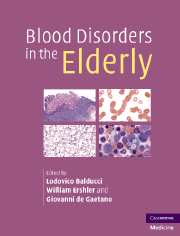Book contents
- Frontmatter
- Contents
- List of contributors
- Preface
- Part I Epidemiology
- Part II Hematopoiesis
- 5 Stem cell exhaustion and aging
- 6 Hematopoietic microenvironment and age
- 7 Replicative senescence, aging, and cancer
- 8 Qualitative changes of hematopoiesis
- 9 Aging and hematopoietic stress
- 10 Immunoglobulin response and aging
- 11 Biological and clinical significance of monoclonal gammopathy
- Part III Anemia of aging
- Part IV Hematologic malignancies and aging
- Part V Disorders of hemostasis in the elderly
- Index
8 - Qualitative changes of hematopoiesis
from Part II - Hematopoiesis
Published online by Cambridge University Press: 21 October 2009
- Frontmatter
- Contents
- List of contributors
- Preface
- Part I Epidemiology
- Part II Hematopoiesis
- 5 Stem cell exhaustion and aging
- 6 Hematopoietic microenvironment and age
- 7 Replicative senescence, aging, and cancer
- 8 Qualitative changes of hematopoiesis
- 9 Aging and hematopoietic stress
- 10 Immunoglobulin response and aging
- 11 Biological and clinical significance of monoclonal gammopathy
- Part III Anemia of aging
- Part IV Hematologic malignancies and aging
- Part V Disorders of hemostasis in the elderly
- Index
Summary
Introduction
This chapter explores the association of aging and qualitative abnormalities of hematopoiesis. While incidence and prevalence of benign and malignant hematologic conditions increase with age, it is not clear whether quantitative or qualitative abnormalities of hematopoiesis underlie these changes. A definition of the mechanisms by which older individuals are more vulnerable to hematologic diseases is necessary for their prevention and treatment.
A common example of a hematologic abnormality in the elderly is unexplained anemia . Controversy lingers over whether hematopoietic exhaustion, erythropoietic abnormalities due to genomic damage, increased vulnerability to environmental stress, or a combination of these factors may lead to anemia. Likewise, changes in lymphocytic phenotype, a decline in immune function (immunosenescence), and reduced chemotaxis and bactericidal capacity of neutrophils have been reported in older individuals. Despite these changes, hematopoiesis appears adequate to maintain the homeostasis of the peripheral blood elements both in healthy elderly persons and in aging experimental animals, in the absence of hematopoietic stress.
Aging may be considered a condition of enhanced vulnerability to stress due to loss in functional reserve of multiple organ systems and simultaneous decline in personal and social resources. Both environmental and genomic changes may conspire to restrict the functional reserve of the aged.
- Type
- Chapter
- Information
- Blood Disorders in the Elderly , pp. 95 - 119Publisher: Cambridge University PressPrint publication year: 2007
- 1
- Cited by



